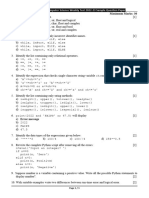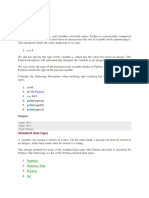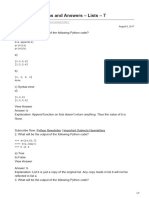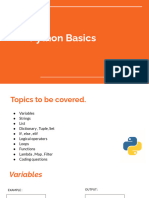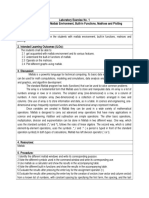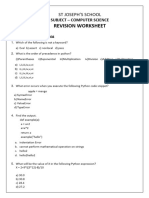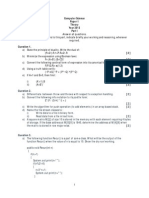Python_Notes_Fixed-1
Uploaded by
LakshayPython_Notes_Fixed-1
Uploaded by
LakshayPython Basics - Comprehensive Notes
1. Variables and Print Statements
No need to declare variables before assigning them.
Use print() to display output. Python code blocks are determined by indentation.
Example:
x = 10
print(x) # Output: 10
2. Arithmetic Operations
* operator can multiply strings with numbers.
Example:
print('Spam ' * 4) # Output: Spam Spam Spam Spam
3. Type Conversions
int(3.33) -> 3
float(10) -> 10.0
int('100') + 1 -> 101
4. Jupyter Notebook Shortcuts
Esc + A -> Create a new cell above
Esc + B -> Create a new cell below
5. Power Operator
a ** b calculates power.
Example:
a=2
b=3
print(a ** b) # Output: 8
6. Swapping Lists
Unlike C++, lists can be swapped directly:
a, b = [1, 2, 3], [4, 5, 6]
a, b = b, a
print(a, b) # Output: [4, 5, 6] [1, 2, 3]
7. Functions
Use help() to get function details.
Example:
help(round)
8. Boolean Values
Example:
def can_run_for_president(age):
return age >= 35
print(can_run_for_president(19)) # Output: False
9. Lists
Lists support slicing and built-in functions like len(), sorted(), sum().
10. Loops
For and while loops help iterate over sequences.
Example:
for x in ['a', 'b', 'c']:
print(x, end=' ') # Output: a b c
11. List Comprehensions
Example:
squares = [n**2 for n in range(10)]
12. Strings
Use escaping characters and string operations like split() and join().
Example:
datestr = '1956-01-31'
year, month, day = datestr.split('-')
13. Dictionaries
Example:
numbers = {'one': 1, 'two': 2, 'three': 3}
print(numbers['one']) # Output: 1
14. External Libraries
Use math and numpy for advanced operations.
Example:
import math
print(math.pi) # Output: 3.141592653589793
You might also like
- Isc Specimen Paper Computer Science Paper 1 (Theory)No ratings yetIsc Specimen Paper Computer Science Paper 1 (Theory)7 pages
- ISC 2005 Computer Science Paper 1 TheoryNo ratings yetISC 2005 Computer Science Paper 1 Theory6 pages
- Sol PYTHON PROG - III Sem Question Paper (2023-24) OddNo ratings yetSol PYTHON PROG - III Sem Question Paper (2023-24) Odd25 pages
- SYBSc(CS) Electronics Practical Sem IV Introduction to PythonNo ratings yetSYBSc(CS) Electronics Practical Sem IV Introduction to Python23 pages
- Matlab: Window, Where The Special Prompt Appears. This Prompt Means That MATLAB Is Waiting For ANo ratings yetMatlab: Window, Where The Special Prompt Appears. This Prompt Means That MATLAB Is Waiting For A20 pages
- Computer Science Paper 1 Theory Year 2013No ratings yetComputer Science Paper 1 Theory Year 20138 pages




